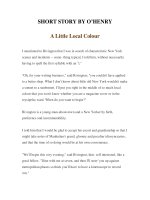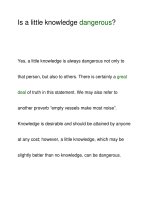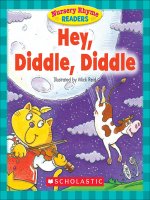nursery rhyme readers mary had a little lamb
Bạn đang xem bản rút gọn của tài liệu. Xem và tải ngay bản đầy đủ của tài liệu tại đây (7.21 MB, 14 trang )
Mary Had a
Little Lamb
Illustrated by Anthony Lewis
No part of this publication may be reproduced in whole or in part or stored in a retrieval system, or transmitted in any
form or by any means, electronic, mechanical, photocopying, recording, or otherwise, without written permission of the
publisher. For information regarding permission, write to Scholastic Inc., 557 Broadway, New York, NY 10012.
Designed by Jaime Lucero
ISBN: 978-0-545-26774-8
Copyright © 2010 by Scholastic Inc.
All rights reserved. Published by Scholastic Inc.
12 11 10 9 8 7 6 5 4 3 2 1 10 11 12 13 14 15/0
N
u
r
s
e
r
y
R
h
y
m
e
N
u
r
s
e
r
y
R
h
y
m
e
READERSREADERS
Nursery Rhyme Readers: Mary Had a Little Lamb, Scholastic Teaching Resources
2
Mary had a little lamb
Nursery Rhyme Readers: Mary Had a Little Lamb, Scholastic Teaching Resources
3
with fleece as white as snow.
Nursery Rhyme Readers: Mary Had a Little Lamb, Scholastic Teaching Resources
4
And everywhere that Mary went,
Nursery Rhyme Readers: Mary Had a Little Lamb, Scholastic Teaching Resources
5
the lamb was sure to go.
Nursery Rhyme Readers: Mary Had a Little Lamb, Scholastic Teaching Resources
6
He followed her to school
one day,
Nursery Rhyme Readers: Mary Had a Little Lamb, Scholastic Teaching Resources
7
which was against the rule.
Nursery Rhyme Readers: Mary Had a Little Lamb, Scholastic Teaching Resources
8
It made the children laugh and
play to see a lamb at school.
Nursery Rhyme Readers: Mary Had a Little Lamb, Scholastic Teaching Resources
6
Teaching Tips
To enhance children’s reading experiences, use these tips
as you introduce and share the Nursery Rhyme Readers.
Before Reading
Show the cover of the book and read aloud the title.
Have children comment on the cover illustration and
tell what they know about the nursery rhyme. Since
nursery rhymes often contain unfamiliar vocabulary,
skim the book and introduce any vocabulary that will help
children’s understanding of the story. For example, for Little
Miss Muffet, discuss tuffet, curds, and whey.
During Reading
The first time through, read the nursery rhyme aloud from beginning to end to let children hear the
rhyme, enjoy it, and get a feel for the language. On subsequent readings, help engage children in the
reading process by following these suggestions.
L
Model reading for children by tracking a line of print from left to right, turning the pages, and
using picture clues. Invite children to comment on the illustrations on each page.
L
Reread the story, asking children to listen for words that rhyme. Then read aloud again, this time
stopping at words that rhyme and letting children chime in on them. Next, invite children to join
in for a shared reading, pointing to each word as you read it.
L
Model strategies for decoding words, such as finding beginning sounds, using picture clues, and
sounding out words.
L
Point out punctuation and capital letters. Discuss what symbols such as periods,
commas, questions marks, and exclamation marks mean, and how they affect the
reading of the rhyme.
L
Invite children to clap their hands along with you to the rhythm of the rhyme as
you read aloud.
After Reading
Help children respond to the nursery rhyme by following these suggestions.
L
Ask questions to check for understanding. For example, after reading
Humpty Dumpty, ask questions such as: What happened to Humpty when he
fell? Who tried to help Humpty after he fell? Why couldn’t the king’s horses and
men put Humpty back together?
Nursery Rhyme Readers Teaching Guide © Scholastic Teaching Resources
7
L
Ask children if they liked the rhyme, and what they liked most or least.
Have them retell the rhyme in their own words.
Using the Reproducible Nursery Rhyme Pages
After reading a nursery rhyme several times, give children a copy of the nursery
rhyme reproducible to use for independent reading, for reading in pairs or groups,
for classroom activities, and for sharing with
family members. These pages are a great way to
encourage repeated readings, develop fluency, and
to do specific skill work.
Have children make a folder of the nursery
rhyme pages. Provide a blank folder for children to
title “My Nursery Rhymes,” and let them decorate
it. Have them insert the nursery rhymes as they read
them. They can also keep the Nursery Rhyme
Reader Log in the folder, as well as activity
sheets that they complete. Let children take
home the folder to share with family members
from time to time.
Have children follow along as you read
the rhyme, tracking the print as you read. Ask them to underline or circle
the rhyming words on their sheet. Also use the pages to have children
identify specific letters, words with specific consonants, blends, vowel
patterns, phonograms, and sight words. (You might wish to enlarge one copy
of the rhyme and place it on an easel for children to see.)
Some of the lesson pages have specific suggestions for using the reproducible
versions of the nursery rhymes.
Using the Lesson Pages and Reproducible
Activity Pages
For each Nursery Rhyme Reader, use the activities on the lesson page found in
this teaching guide to delve further into the areas of phonemic awareness, phonics,
comprehension, vocabulary, reading, and writing. Each nursery rhyme includes a
reproducible activity page specific to it. Spread the lesson and activities for each
rhyme over several days.
Nursery Rhymes Readers Teaching Guide •
© 2010 Scholastic • 26
Mary Had a
Little Lamb
Mary had a little lamb
with fleece as white as snow.
And everywhere that Mary went,
the lamb was sure to go.
He followed her to school
one day,
which was against the rule.
It made the children laugh and
play to see a lamb at school.
Nursery Rhymes Readers Teaching Guide •
© 2010 Scholastic • 42
Name ___________________________________________________________
Mary Had a Little Lamb
Write Your Own Story!
Mary’s lamb followed her
__________________________________________
_____________________________________________________________________________
.
What happened?
_____________________________________________________
_____________________________________________________________________________
.
to soccer
practice.
It got the ball and
butted it into the goal.
Jack
Nursery Rhyme Readers Teaching Guide © Scholastic Teaching Resources
Nursery Rhyme Readers Teaching Guide •
© 2010 Scholastic • 26
Mary Had a
Little Lamb
Mary had a little lamb
with fleece as white as snow.
And everywhere that Mary went,
the lamb was sure to go.
He followed her to school
one day,
which was against the rule.
It made the children laugh and
play to see a lamb at school.
27
Mary Had a Little Lamb
Learning With the Nursery Rhyme
See pages 6–7 for suggested ways to read and share the book with
children. Then focus on the following activities.
What’s the Big Idea? Tell children that stories have a main
idea, or big idea. Write the following sentences on the chalkboard
or on chart paper and read them aloud. Ask children which one
tells the main idea.
Mary’s lamb was white.
Mary’s lamb followed her everywhere.
Mary’s lamb made the children laugh.
Guide children to see that the second sentence tells the main idea.
Create a graphic organizer such as the one at right. Have children
fill in the organizer with details from the story. Be sure to direct
their attention to the picture clues on pages 4–5 of the reader.
Write Your Own Story! Give each child a story prompt sheet found on page
42. On the lines, have them write or dictate where else the lamb followed Mary
and what happened when they got there. Encourage children to be as silly as they
like! Have children draw a picture to illustrate their story and share their page
with the class.
Silly Sentences Slowly, say, “little, lamb.” Ask children if they can tell what
sounds the same in these two words. Guide them to see that both words start
with the /l/ sound. Read the last page and have children identify another word
that starts with /l/ (laugh). Generate a list of other words that start with l on the
chalkboard. Then have children make up silly, alliterative sentences using words
with /l/. For example: Lydia’s lucky lamb licks lollipops. Create a book using the
sentences and have each child illustrate his or her sentence.
Which Sound? Explain to children you are going to play a word game. You
will say three words and you want children to listen closely and tell you what
sound they hear in the middle of these words. Use word lists with long vowel
sounds such as the following.
fleece meet keep /e/ school rule tune /oo/
find white dime /i/ day made play /a/
go boat snow /o/
Colorful Collages Ask children if they know what fleece is. Explain that it is a word for the wool
covering on a lamb. It is also a name for a material used in light jackets, gloves, and other clothing
items. Ask what words in the rhyme are used to describe the lamb’s fleece. (white as snow) Have pairs
or small groups of children pick a color word and then make a collage showing things of that color.
They can use magazine pictures and also items such as yarn, cotton, clothing scraps, and so on.
Nursery Rhymes Readers Teaching Guide •
© 2010 Scholastic • 42
Name ___________________________________________________________
Mary Had a Little Lamb
Write Your Own Story!
Mary’s lamb followed her
__________________________________________
_____________________________________________________________________________
.
What happened?
_____________________________________________________
_____________________________________________________________________________
.
to soccer
practice.
It got the ball and
butted it into the goal.
to the
pond
to the
library
to the
store
to the
field
to
school
Mary’s lamb
followed her
everywhere.
Jack
-
-
-
-
Nursery Rhyme Readers Teaching Guide © Scholastic Teaching Resources
Nursery Rhymes Readers Teaching Guide •
© 2010 Scholastic • 42
name ___________________________________________________________
Mary Had a Little Lamb
Write Your Own Story!
Mary’s lamb followed her __________________________________________
_____________________________________________________________________________.
What happened?
_____________________________________________________
_____________________________________________________________________________.









